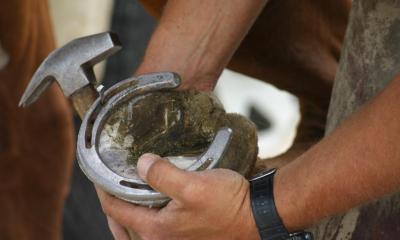
Farriers attend to horses' feet and re-shoe them using correctly sized ready-made shoes or bespoke shoes made from metal. The work requires skill and physical fitness. Our guide will help you to start up and run your own farriery business.
- Research your target market
- Your farriery services
- Establish your customer profiles
- Price your services
- Promote your business
- Approved Training Farrier
- Buy an existing business
Research your target market
Estimate demand
You will need to find out the current level of demand in your area for farriery services. Because becoming a farrier normally involves completing a lengthy apprenticeship, in some areas there is a shortage of farriers. This would mean steady demand for the services you can provide, although if you plan to operate only from a workshop you might be undercut on price by mobile farriers.
A browse on online directories will give you an idea of how many farriers are already operating in your area and the range of services they offer. Another good way to find out is to look on the Farriers Registration Council website - you will be able to access a list of registered farriers in Great Britain sorted by postcode.
As well as checking out the competition make sure your area has lots of 'horsey' people, equestrian events and activities. Ideally you will be near businesses such as riding schools, trekking centres and racing stables and there should also be lots of demand from private horse and pony owners. Is there an active Pony Club? Will you be near racecourses and showgrounds? Is the area well provided with livery yards, saddleries, tack shops and vets with expertise in equine matters?
As part of your market research you could talk to other equestrian businesses about the local horse population and how popular riding is in your area.
If possible, visit other farriers to find out:
- the range of farriery services they offer - for example, do they specialise in, say, racing plates
- their charges
- whether they also offer mobile services
- how busy they are - how soon could they attend to a horse?
- if they also undertake blacksmithing work, for example ornamental gates or repairs
Don't forget that during periods of economic downturn horse owners might be tempted to increase the interval between replacing shoes - or even use the services of cheaper, illegal 'farriers'. Some owners might be forced to sell their horses because they can no longer afford to keep them.
Why will customers choose your farriery business?
Consider why customers will choose you rather than another farriery business. It may be that you can offer a specialist service, for example to racing stables. Or you might be prepared to work at weekends, or later hours in the evening, when other businesses are closed. Be wary about competing mainly on price - horse owners are generally prepared to pay for the provision of a good quality service. Charging low prices might mean that you have to rush to deal with enough horses to bring in the amount you want to earn.
Once your business has become established you are likely to find that your customers remain very loyal to you, provided that you offer a good quality service. Make sure you take the time to communicate with your clients - simple things like letting them know if you're running late can mean the difference between retaining or losing their business.
Research current trends, plus legal and tax issues
Your farriery services
Farriers prepare and treat horses' feet before making and shaping metal shoes (or using ready-made ones) and fixing them to the horse's hoof with nails or studs. To do this you will need to be a skilled craftsperson with a good knowledge of the anatomy of a horse's foot and how it works.
The traditional shoeing procedure involves a number of stages:
- removing the old shoes
- inspecting the horse's feet and removing any overgrowth
- measuring the feet
- selecting the appropriate ready-made shoes or the raw steel if the shoes are to be made
- selecting the right nails or studs
- making the new shoes in the forge or working on ready-made ones
- fitting the shoes, using the appropriate weight and shape of hammer
Recently, plastic glue-on shoes have been developed as alternatives to metal shoes - for example where the horse or pony has laminitis. The shoe is softened in hot water and then moulded to the hoof and glued on. It takes a few minutes to cool down and set. Flexible hoof wraps are used in similar situations.
Farriers with the appropriate training and experience can undertake corrective farriery, which might involve reshaping the hoof wall or sole. Invasive farriery, which involves opening the hoof capsule, is only done under a vet's direction.
A qualified farrier must be able to shoe all classes of horse and is often asked to attend to the feet of other animals such as goats, sheep and cattle.
A horse's hoof grows all the time and so will need re-shoeing every four to eight weeks, depending on the time of year and the work it does. For example, during the season a hunter might be re-shod every four weeks. Horses that are turned out to grass (unshod) in the summer also need their feet seen to every six weeks or so.
Part of your role will be to advise customers on how frequently their horse needs to be re-shod and how to keep their horse's feet healthy and pain-free. You are also likely to work alongside your local vet in cases where there is disease to the horse's feet. You may be able to form a partnership with your local veterinary practice and become their farrier of choice.
In some cases you may work on horses at the owner's premises using a mobile forge, rather than at your own workshop.
Other services to offer
As well as undertaking farriery work you might decide to do some general blacksmithing work, perhaps during quieter times of the year. You might decide to produce items such as ornamental gates, fireplace and garden accessories, or to offer a repair service for agricultural equipment.
Your equipment
In order to provide farriery services you will need a range of specialist equipment and tools. Some of these you will be able to make yourself.
You will need:
- workshop and/or portable forge. These are commonly fuelled by gas
- an anvil on which to work the hot metal
- a guillotine to cut lengths of metal, to make shoes
- a work bench
- power tools (such as welders and grinders)
- tools for use at the forge and on the anvil. These include turning hammers, tongs, stamps, hot rasps, punches and so on
- shoeing tools, to remove old shoes, prepare the horse's foot and nail on the new shoes. These include hammers, nippers, pincers, pullers, parers, knives, rasps, cutters and files
You will also need protective clothing such as a leather apron and safety goggles to protect you from the heat and sparks.
Suppliers to the farriery sector are listed on the Forge & Farrier website. Farrier Supplies Northern Ireland (FSNI) distributes a wide range of horseshoeing products to farriers in Northern Ireland. Visit the FSNI website for details.
Horseshoes
You may decide to buy in ready-made shoes, make them yourself from mild steel or aluminium alloys, or do a mix of both. The design of a horseshoe varies, depending on the type and weight of horse and the work it does, but basically each horseshoe has:
- a toe
- two quarters
- a heel
A horseshoe has an upper and a lower surface and an inner and outer edge.
A pair of horseshoes is either two front or two hind shoes. A pair of each is a set. The front and hind shoes in a set are not the same size.
A remove is a part-worn horseshoe which has been taken off and then put back on. A refit is a shoe which has been taken off, refitted and then put back on again.
The horseshoe is fixed onto the horse's hoof with nails, so each horseshoe has a certain number of holes punched in it (for example, seven or eight).
Plastic horseshoes are also available, for cases where traditional shoeing methods are not appropriate. For example the horse may have laminitis or other foot/hoof problems. The horseshoes are moulded into shape and fixed to the hoof with glue.
Visit the Arthur Cottam Horseshoe Company website for details of the wide range of horseshoes available.
Establish your customer profiles
Your customers will be private horse and pony owners as well as local equestrian businesses such as:
- riding schools
- trekking centres
- racehorse training yards
- studs
- equine welfare trusts and sanctuaries
- livery stables
(Although you may be called out by livery stables, generally you would invoice the horse's owner direct unless the owner was paying for competition or full livery.)
Price your services
Make sure that the difference between the cost price of the metals and sundries you use (or the ready-made shoes you buy in) and the prices you charge is enough to cover all of your operating costs, including your own drawings. But the prices charged for shoeing vary around the country and you will have to price in line with what your local market will bear.
There are a number of things to take into account when fixing your charges:
- how many sets of shoes will you be able to fit in a day. For example, in a normal working day, you might shoe five horses but in the busy summer months you might deal with double this number, by working long hours
- how many trims will you be able to fit into a normal day
- how much travelling between jobs you expect to do
- what sort of work will you be undertaking - you would make a higher charge for specialist shoes or for working on problem feet
Typically a fee of between £40 and £80 is charged for re-shoeing, although it can be much more than this in some circumstances and depending on the shoes required. British Horse Society guidance on the cost of keeping a horse or pony gives the following information:
- shoeing every six to eight weeks - £80
- trimming every six to eight weeks - £35
- remedial shoeing every four to six weeks - £120
Other things to consider when setting your prices include:
- the number of horses you are likely to have on your books
- the shoeing interval for each horse, for example every six weeks
- the cost of items that you use in the course of your work but may not charge out separately, for example astringent powder, stockholm tar, cotton wool and so on
Special offers and discounts
You might decide to offer discounts to certain customers, for example to private horse owners who ask you to work on several horses at the same time, or to local equestrian businesses that use your services on a regular basis. Make sure that any discounts you offer do not erode your profit margins too far, particularly if you are incurring significant travelling expenses attending to these customers.
Loyalty schemes
You could think about running a loyalty scheme that rewards regular customers. Each time you carry out a service for them they earn points - when they have built up a certain number they get a discount off their next invoice.
Promote your business
Whichever services you plan to offer, it is important that potential customers know about you. If you work in Great Britain you'll benefit from being included in the Farriers Registration Council (FRC), 'Find a Farrier' directory, and you are entitled to display the FRC vehicle window sticker. There are several other things you can do to promote your business:
- make sure you have a very visible presence at local horse shows and events, or even sponsor a show
- build up good relationships with equestrian businesses, livery yards, riding clubs and vets so that you benefit from word of mouth recommendations
- advertise in local newspapers and leisure directories or have some leaflets printed that you distribute to equestrian businesses in your area (make sure that your promotional material complies with FRC guidelines on advertising)
- set up your own website, including plenty of images of the type of work you can do. You could ask some of your clients if you could refer to them on your website and include links to their own sites
- use social media like Facebook or Twitter to let clients know about new developments (make sure that any comments you post comply with the FRC Guide to Professional Conduct)
Approved Training Farrier
You might decide to apply to become an Approved Training Farrier (ATF), to train apprentices. You must:
- be a registered farrier for at least four years
- have a fixed forge
- be qualified to either AWCF or to an accepted alternative qualification
- have passed the Train the Trainer Farrier Award (TTFA)
- undertake mandatory continuing professional development (CPD) each year
You will be entered on the list of ATFs maintained by the Farriers Registration Council (FRC). To be entered on the list you must have agreed to work with one of the three approved colleges that offer training leading to the WCF Diploma in Farriery. The colleges provide compulsory annual training courses for all ATFs to ensure that standards are being maintained. Visit the FRC website for more information.
Buy an existing business
You might decide to buy an existing farrier business rather than start your own venture from scratch. Buying a going concern can mean that the products, customers, regular sales, staff, premises and equipment are already in place.
But buying a business can be a hazardous, expensive process unless you have the right skills and experience on your team, including legal and financial know-how. Establish the genuine trading and financial position, so that the price you pay for the business is not too high.


